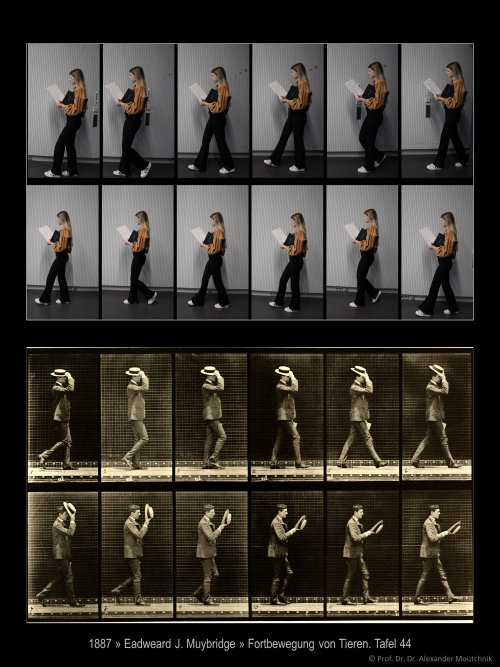EN:1887 Muybridge
Inhaltsverzeichnis
[Verbergen]Photo quote
#study | #bachelorthesis | #hochschulerheinmain | #hsrm | #photoquotes
The quote shows a sequence of movements of a female student of the RheinMain University of Applied Sciences in Wiesbaden in a series of twelve pictures. She is walking down a corridor on the Campus Unter den Eichen (Building B) holding her finished bachelor's thesis in her hands, as she is about to hand it in at the secretary's office.
Original photo
#muybridge | #man | #walking | #takingoffhat | #locomotion | #motion sequence | #picture series
Records of ownership
Penn University Archives & Records Center - "Male, Walking, taking off hat"[1]
Description
The photograph "Walking, taking off hat" or "Animal Locomotion, 1887, plate 44" was taken in 1887 and consists of a series of twelve photographs. A man in a suit walks from left to right in front of a chequered wall. The sequence of movements in the series shows the man's gait and how he removes his hat, which he had previously been wearing on his head, step by step towards the front.
Photographer
Eadward J. Muybridge was born on 9 March 1830 in Kingston-upon-Thames in England.[2] In 1852, Muybridge moved to the United States and chose San Francisco as his new residence from 1855. He began his work as an assistant to several photographers and in 1866 focused on landscape photography.[3] In order to create photographs from the most spectacular perspectives, he abseiled into the canyons of Yosemite Valley, for example. He was also already well ahead of his time in having distracting objects removed from his potential photographic backdrops or creating collages if he could not fit all the details he would like to depict in the detail he was photographing. Muybridge focused on sequences of movements, which he captured with the help of serial photographs. To do this, he connected several cameras in series. This was the first time he was able to capture a horse galloping with all four legs in the air at the same time. He developed many more series with sequences of movements. However, with the zoopraxiscope, a device that Muybridge developed himself, it was possible to project the series photographs as a sequence. In this way, he laid the foundation for the moving image. In 1894 he moved back to his birthplace, published two textbooks and died in Kingston-upon-Thames on 8 May 1904.[4]
Background and origins
Muybridge published eleven volumes of photographs entitled Animal locomotion. All the photo volumes (plates) show locomotion. More than 500 plates show humans, about 100 plates show the gaits of horses, 120 plates show the locomotion of deer, elephants, dogs, pigs, bulls, lions, cats and parrots. "Walking, taking off hat" is one of the series showing the movement patterns of humans.[5]
Analysis
As one of the series on movement sequences of humans, "Walking, taking off hat" shows the movement sequence of a man taking off his hat. This series, like many others of this kind, is part of Muybridge's work and shows his aim to capture individual movements, but also to make movements in a sequence of picture series come alive by projecting them.
Impact and reception
Through his works on sequences of movements, Muybridge has succeeded in freezing movements and making them visible and comprehensible in detail. His series of images, made by taking many photographs in succession and using the zoopraxiscope to project them, pioneered chronophotography as well as the moving image.[6].
Quotes from Eadward J. Muybridge
"Only photography has been able to divide human life into a series of moments, each of them having the value of a complete existence."[7]
"If I fail, you will never hear of me again." [8]
Literature
- Johnson, Brooks (1989): Photography speaks. 66 Photographers on Their Art, Aperture, The Chrysler Museum, Norfolk, Virginia, pp. 20-21.
- Lempertz.com (n.d.): "Muybridge, Eadweard"[9].
- Musee-orsay.fr (o.J.): "Eadweard Muybridge : obstacle jump, black horse"[10]
- Ooegeschichte.at (o.J.): "Eadweard Muybridge: horses in motion"[11]
- Sammlung.städelmuseum.de (o.J.): "Eadweard Muybridge: Physicist and Photographer"[12]
Sources
- Hochspringen ↑ https://archives.upenn.edu/collections/finding-aid/upt50m993
- Hochspringen ↑ https://www.lempertz.com/de/kataloge/kuenstlerverzeichnis/detail/muybridge-eadweard.html
- Hochspringen ↑ https://sammlung.staedelmuseum.de/de/person/muybridge-eadweard
- Hochspringen ↑ https://www.lempertz.com/de/kataloge/kuenstlerverzeichnis/detail/muybridge-eadweard.html
- Hochspringen ↑ https://www.musee-orsay.fr/de/kollektionen/werkbeschreibungen/suche/commentaire/commentaire_id/saut-dobstacle-cheval-noir-11199.html?no_cache=1
- Hochspringen ↑ https://www.ooegeschichte.at/themen/mensch-und-natur/mensch-pferd-lambach/eadweard-muybridge-pferde-in-bewegung
- Hochspringen ↑ Eadweard Muybridge (goodreads.com (n.d.): "Eadweard Muybridge: Quotes". Retrieved from https://www.goodreads.com/author/quotes/312312.Eadweard_Muybridge (31.03.2021)
- Hochspringen ↑ Eadweard Muybridge (inspiringquotes.us (o.J.): "Eadweard Muybridge Quotes and Sayings - Page 1". Retrieved from https://www.inspiringquotes.us/author/8090-eadweard-muybridge (31.03.2021)
- Hochspringen ↑ Retrieved via https://www.lempertz.com/de/kataloge/kuenstlerverzeichnis/detail/muybridge-eadweard.html (31.03.2021)
- Hochspringen ↑ Called via https://www.musee-orsay.fr/de/kollektionen/werkbeschreibungen/suche/commentaire/commentaire_id/saut-dobstacle-cheval-noir-11199.html?no_cache=1 (31.03.2021)
- Hochspringen ↑ Called via https://www.ooegeschichte.at/themen/mensch-und-natur/mensch-pferd-lambach/eadweard-muybridge-pferde-in-bewegung/ (31.03.2021)
- Hochspringen ↑ Called via https://sammlung.staedelmuseum.de/de/person/muybridge-eadweard (31.03.2021)
